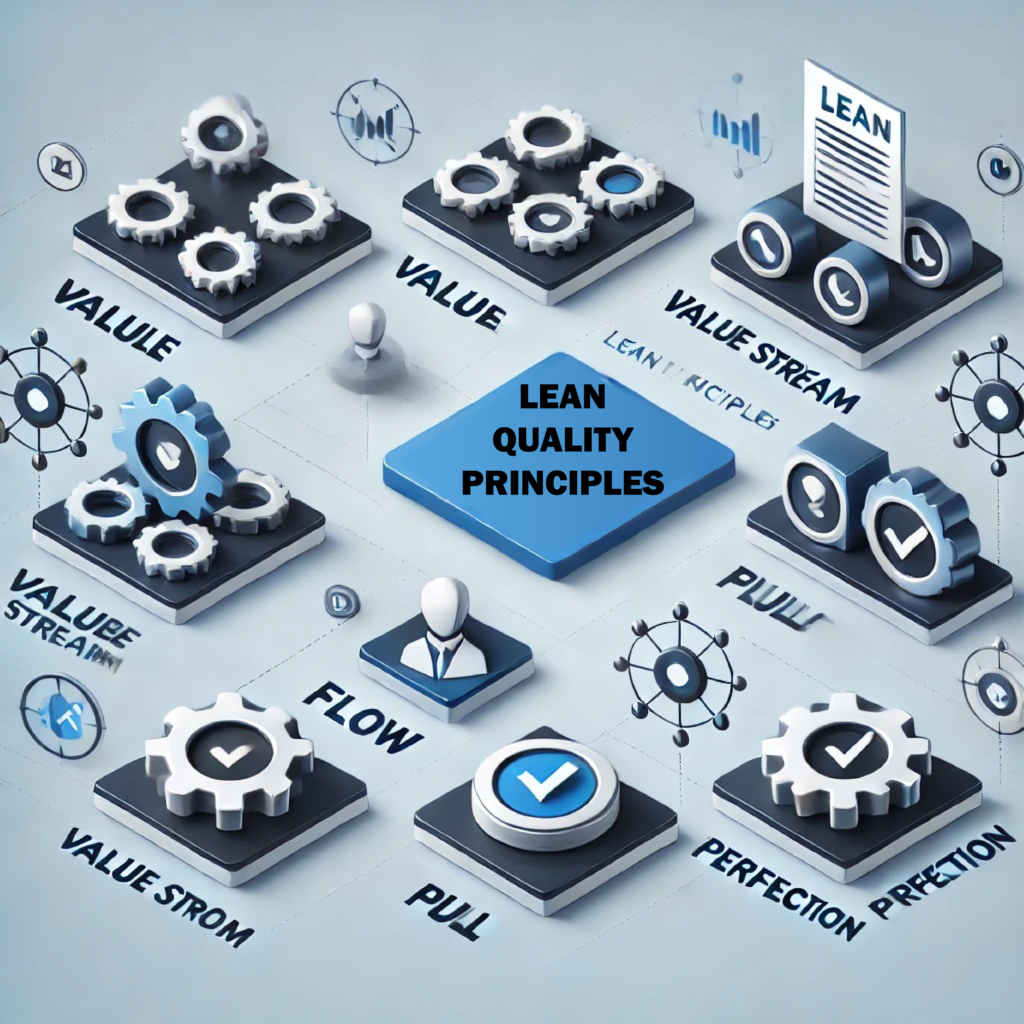
Improving Process Efficiency with Lean Quality Principles in 2025
Introduction
For today’s business, where every situation is fast and speedy, being able to increase process efficiency is necessary for keeping up to meet or even exceed those competitors. Lean quality principles are one of the most effective methodologies for increasing productivity, reducing waste, improving quality. The success of Lean principles in driving process improvement has resulted in a wide use of Lean outside of manufacturing – from healthcare to finance.
Here we will go through the basic Lean principles, why they are beneficial, and how to work Lean in your organisation thus changing the way you work and create a culture of continuous improvement.
What Are Lean Quality Principles?
As Lean principles are focused on delivering maximum value to the customer while minimising waste and inefficiencies. They were based on the Toyota Production System (TPS), that they were streamlined processes, eliminating non value adding activities. The principles are indispensable to improve both quality and process efficiency with their result being increased customer satisfaction. With five key pillars summarized, there are lean principles that we can use.
- Value – Identify what the customer values and focus on delivering it.
- Value Stream – Map all activities in the value stream and eliminate unnecessary steps.
- Flow – Create a seamless flow of production to prevent delays and bottlenecks.
- Pull – Produce only what is needed, reducing overproduction and inventory costs.
- Perfection – Continuously improve processes to reach optimal efficiency.
Benefits of Applying Lean Principles
In particular, with these benefits organizations can realize not only a higher bottom line, but also a stronger position in the market. Applying Lean quality principles in your organization offers numerous advantages, such as:
- Reduced Operational Costs: Reducing costs can be done by optimizing waste, which can bring profitability up.
- Improved Product Quality: By concentrating on customer value and reducing errors, products and services tend to become better.
- Greater Employee Engagement: A culture of involvement is encouraged in Lean, where employees do participate in making improvements.
- Enhanced Customer Satisfaction: Lean principles — minimizing waste through streamlining of process and an emphasis on value — deliver faster, more reliable deliveries.
- Increased Flexibility: Companies with lean operations are also more versatile, since they can better respond to change in demand.
Key Lean Tools and Techniques
Depending on the breadth of Lean implementation necessary, numerous tools and techniques can be used to identify and eliminate inefficiency to implement Lean principles effectively. And here are some of the most popular Lean tools that help to improve the process efficiency. Use of these tools will enable organisations to find hidden inefficiencies, remove waste, and improve process flow resulting in increased productivity and quality standards.
5S (Sort, Set in Order, Shine, Standardize and Sustain).
5S is a workplace organization method, which enables efficiency through an organized and maintained clean standard environment. The ‘S’s stand for each step towards creating a safer and more productive work space.
Value Stream Mapping (VSM)
Value Stream Mapping is a visual how the steps that lead to delivering a product or service. For that it provides teams the opportunity to determine where bottlenecks, redundancies, and other non valuable activities exist in the process and removing them to streamline the process.
Kaizen (continuous improvement)
Kaizen is small continuous changes, done over time, by all employees involved in improvement. It’s a key tool in the drive towards a culture of constant innovation and incremental improvement. A Japanese word ‘Kaizen,’ meaning continuous improvement, has been a cornerstone of Lean quality principles and revolutionized approach of organizations for optimization of the process and quality management. Small, steady improvements when done consistently will work in favor of an entire organisation, according to Kaizen — the fundamental principle of the approach is that incremental changes, when applied in a defined manner, can bring about significant improvements within an organisation.
Kanban
Kanban is a lean business methodology for value added and productivity improvement by continuous improvement and respect for people. It aims at cutting waste and improving the efficacy. Workflow visualisation, limiting work in progress and continuous improvement are key factors of Kanban practices. On Boards, Kanban visualize and track their workflow. Visual cues to control work in transit through multiple stages; balance demand with capacity and overburden prevention.
Root Cause Analysis (RCA)
RCA can figure out the main cause of a problem. Root cause analysis has been famous for being able to find the real cause of the problem and as such, this approach had been emerging as a leading problem solving method that is used widely in different industries. This systematic methodology drills down into the multitude of factors driving adverse events or chronic issues, enabling team work to carefully explore the tangled causation, find the root causes and create therapeutic responses for them.
Just-In-Time (JIT) Production
At the start of JIT manufacturing, you need to evaluate the processes so as to identify and remove waste such as excess inventory and overproduction. Involve your workforce in continuous improvement to remove the inefficiencies before they develop. Form a partnership with suppliers which builds strong supplier relationships, ensuring timely, quality materials, a synchronized supply chain. Move from push to a pull system by real demand and minimize by overproduction. Optimises production layout for natural flow and equips employees to be flexible. The JIT system must be continuous to monitor and adaptable because of changing market demands and technological advances.
Implementing Lean Principles
- Start with a Pilot Project: Test Lean principles in a manageable process or department. If you focus on a single area and get success, you can prove that and scale Lean company wide.
- Engage Leadership and Employees: Wherever Lean is being implemented successfully, leaders and employees have thrown their full hearts into it. Promoting Lean initiatives and involving employees in decision making is the way leadership should behave.
- Provide Training and Resources: Train teams on Lean tools and methods to know what to do and how to do it.
- Set Clear, Measurable Goals: Set specific objectives like reducing waste by a number of percentage points or improving delivery times. Measure success by tracking progress through key performance indicators (KPIs).
- Continuously Improve and Adapt: Lean is not a one off. Help enable a culture of continuous improvement where teams are always looking to improve their processes and cut down on the time spent.
Common Challenges in Lean Implementation and How to Overcome Them
It can be difficult, however, to put Lean principles into practice in an organization with already spelled out processes. Some common obstacles and fixes are below. If such challenges are addressed proactively, organizations can put in place a climate that allows Lean principles to thrive.
- Resistance to Change: It’s difficult for employees to adapt to new methods, particularly if it involves the break of routine. To address this, get them involved in the process, explain to them the benefits.
- Lack of Resources: Investment in training and tools is required, something some companies may be reluctant to spend money on. Show a really long term ROI case in favor of the business for Lean.
- Poor Leadership Support: Lean needs strong leadership backing: if lean is not working, if we aren’t getting results, we have to ask if there is leadership support. Lean culture should be promoted by leadership, who should also acknowledge contributions to process improvement by employees.
Case Study: Lean Implementation Success
Next consider food service organization (FSO), a company which implemented lean principles to lower their production costs and reduce the inefficiencies involved. By value stream mapping, they identified bottlenecks in their assembly line. By applying 5S and Kaizen, they reduced wasted motion and streamlined the layout, resulting in:
- A 25% reduction in production time
- 30% cost savings in materials and labor
- Improved product quality, leading to a 20% increase in customer satisfaction
SFO’s success demonstrates how Lean can transform operations, reducing costs and enhancing product quality.
Conclusion
It is possible to adopt Lean quality principles to dramatically improve process efficiency, increase quality and customer satisfaction while reducing costs. According to Lean, where waste is eliminated, flow improves and so do operations. For any good industry looking to enhance operational performance this is a big thing.
A business can not only increase their competitive advantage and work culture but can also work to implement continuous improvement and innovation through the application of Lean principles. Start your Lean journey now and discover this remarkable effect introducing streamlined, efficient processes.
References:
- A Brief Overview on Toyota Production System (TPS) 2020 https://www.researchgate.net/profile/Anoop-G-M/publication/341784321_A_Brief_Overview_on_Toyota_Production_System_TPS/links/6282ff4edcb5ce0499d6b0c4/A-Brief-Overview-on-Toyota-Production-System-TPS.pdf
- Toyota Production System https://global.toyota/en/company/vision-and-philosophy/production-system/
- Application of Kaizen-Kata
methodology to improve operational problem processes. A case study in a service organization 2021 https://www.emerald.com/insight/content/doi/10.1108/ijqss-07-2020-0113/full/html
